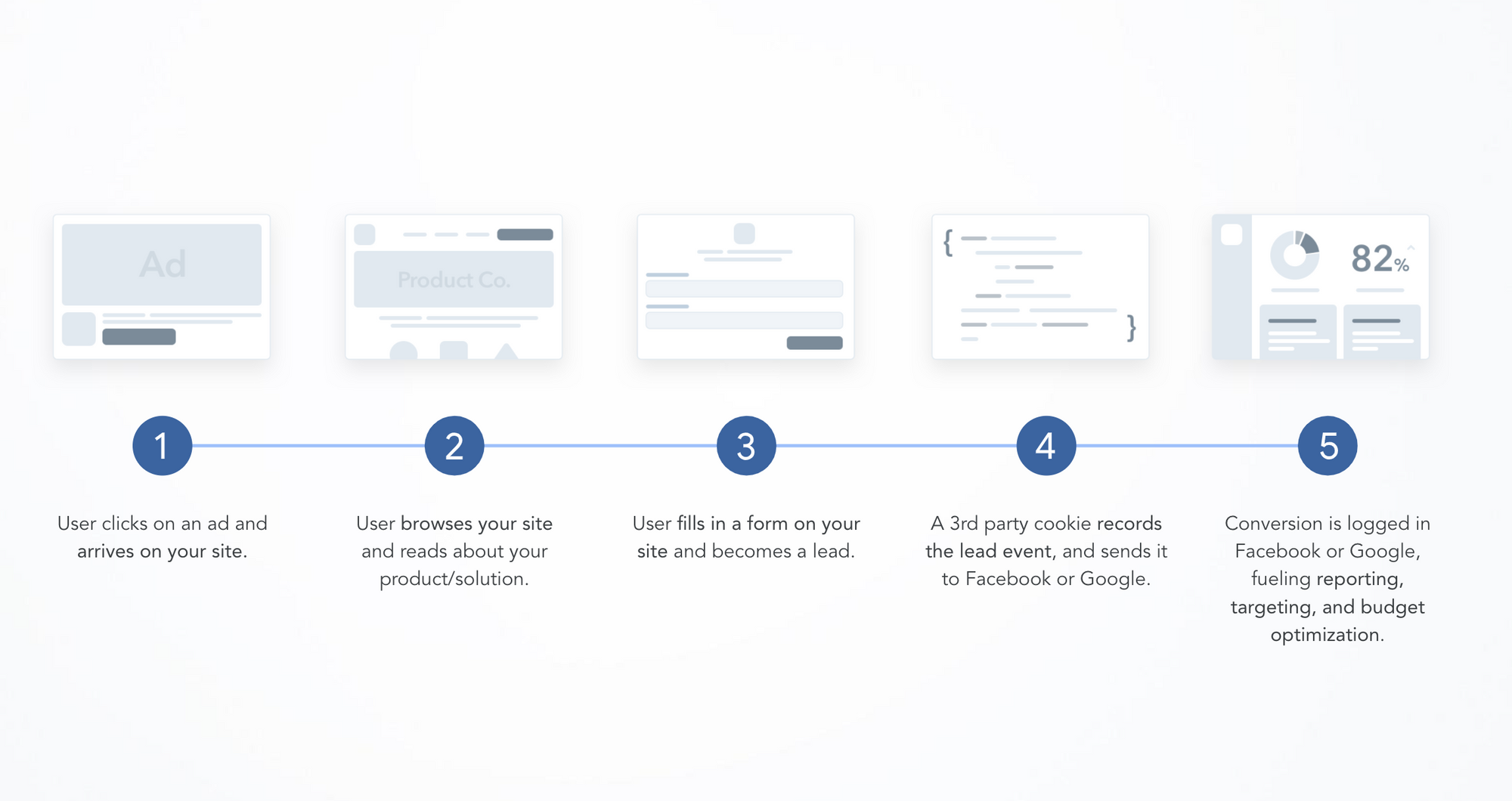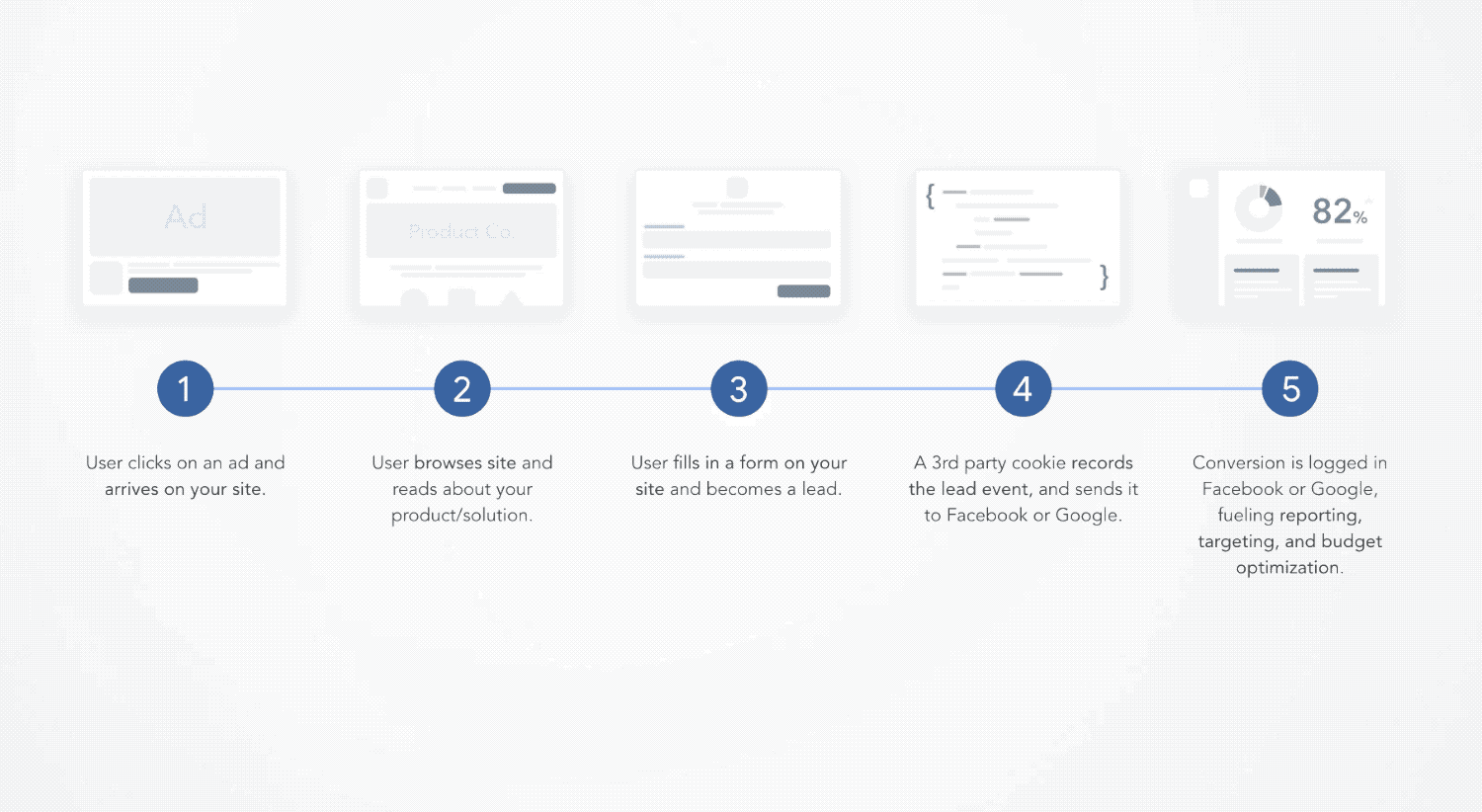The future of B2B advertising: cookieless tracking
When Apple announced that their iOS 14.5 update would allow users to opt out of tracking cookies, advertisers predicted at least 40% of users would opt in. When iOS 14.5 was finally released, advertisers realized just how wrong they were when far fewer users allowed tracking.
This step by Apple is just one of many in the death march of third-party cookies, causing a lot of doomsday chatter among marketers.
But this tectonic shift is actually a game-changing opportunity for B2B advertisers.
What the death of third-party cookies actually means for B2B advertisers
Up until now, we've been relying on third-party cookies for retargeting and conversion tracking.

Retargeting is valuable because you can reach audiences who have stronger intent (they're checking out your site!). Without third-party cookies and the ability to follow users around the internet, retargeting audiences will shrink — and we're already seeing that happen.
The demise of third-party cookies also weakens conversion-tracking — not just for reporting purposes — but for the critical ability to feed conversion data back into platforms, as signals of audience quality, for their machine learning systems to optimize performance.
"When we look at the evolution of advertising systems, it's really an evolution of computing power and machine learning," says Ian Maier, general manager at Clearbit. "So what cookies do is tell tools like Facebook and Google, 'This is a good outcome. Go find me more outcomes like that.'
If you don't make a shift and continue to rely on cookies, business-as-usual, you face:
- Shrinking audiences, as tracking across sites dwindles.
- Declining ad performance, with diminishing conversion signals from third-party cookies to inform platform algorithms on what a good result looks like.

As ad tech has less and less ability to track users across websites, marketers need to change how they approach advertising.
The new best practice: server-side tracking
Bypass the third-party cookie system altogether and send your own first-party conversion signals directly to ad platforms. This is called offline, server-side, or server-to-server conversion tracking — and is a new best practice, recommended both by Facebook and Google.
This method has two clear advantages over the old cookie-based system:
- server-side event tracking can't be obstructed by other technical considerations like ad blockers, browsers, and operating systems.
- you have full control over the data you send, including the ability to send better signals of lead quality, like specific lead-level attributes you're looking for, and the ability to filter out bad signals like spam and what bad fits look like.
When you can determine what data is being sent to platforms like Facebook and Google, you have the power to define what a quality lead looks like and train the algorithms to find more like those. By sending more specific criteria for machine learning models to match, ad platforms can learn how to filter out bots, hobbyists, bad fits, and focus on high-quality leads.
This type of control leads to three great results:
- Qualified audiences. Server-side conversion tracking casts a much more precise net — perhaps catching fewer people but ultimately more high-quality leads.
- Lower cost. When you target fewer but more high-quality leads, you can stop spending money on advertising to irrelevant audiences.
- Better performance. You're spending less money while simultaneously increasing conversions with precise targeting. And as you train the ad platforms even more, this performance continues to improve over time.
Here's an example: Neo4j, a graph database platform, partnered with VertoDigital to implement offline conversion tracking across search, display, and YouTube advertising. Using qualified lead signals — e.g., enterprise lead conversion events — along with predictive lead values and Smart Bidding, Neo4j increased enterprise leads by 157% while simultaneously lowering the cost by 54%.
How to get started with cookieless tracking
You won't get these results overnight. This process takes time, and marketers are going to have trust that the algorithms eventually drive towards a good result.
Crawl: Give the algorithms basic information
You might be tempted to spend time deciding on the perfect data to feed the algorithm in order to train it. "Do not give too much thought to 'is this the best lead status that I can use to start feeding the algorithms?'" says Zoran Arsovski, chief growth officer of VertoDigital. "This is not a silver bullet."
Instead, Zoran says, it's a process — and you have to get started somewhere. Come up with a technical solution — for Google, that means working with its offline conversion tracking, and for Facebook, its Conversions API (not the confusingly, similarly-named but different Offline Conversions API). Then send in some basic offline conversion data and get going with a v1.
Walk: Let the algorithms do the work
As you start getting a grip on how campaigns are structured and the volume you're dealing with — the walk stage is perhaps more a psychological one: stop trying to control the process. "Should I make three versions ... and test which one is working best? No," says Arsovski.
The goal is not to get information out of the algorithms to discover what ad, etc. is working best; the goal is to train the algorithms and let them learn and do the work for you.
Today’s best practices:
- Feed the algorithms lots of information while making sure you're sending in the "right" signals.
- Run as few campaigns as possible with limited ad sets.
- Keep your audience as broad as possible to be able to feed the algorithm more data — and only divide your audiences when you want to personalize.
- Focus on the creative — which is what your audiences will see and respond to (or not).
- Be patient; it takes 3-4 weeks to see results.
After you start to see results, you can get more creative, increase budgets, add additional pages, and more.
You may also be tempted to take a shortcut and send all won revenue events to the algorithm instead of leads. But because algorithms rely on volume, this tactic won’t work well. You need to strike the right balance between sending quality conversion data and sending enough of it.
Letting machine learning do its job will not only ensure you get the most accurate, optimized results, but it will also help you free up your time for other tasks.
Run: Score leads for value-based bidding
As the algorithm starts learning, you can start scoring the leads and assigning them a dollar value based on their behavior or data, then send that back to the ad platforms to train them further.
This allows you to do value-based bidding because you have taught the algorithm how to look not just for a form fill or a site visit but for specific behaviors and data that lead to high-intent leads to maximize every dollar you spend.
Get to run faster: Clearbit Conversions
A quick note before we go. While server-side conversion tracking is the future of B2B advertising, actually getting it implemented on Google and/or Facebook can still be quite a challenge — taking a lot of work, technical know-how, maintenance, and time.
You'd need to go through a string of steps in your ad platform, lead forms, and CRM to manually set up this system. Here's an example of what that might look like for the Google Ads platform:

We built Clearbit Conversions to make using offline or server-side conversion tracking much easier. Clearbit Conversions is quick to set up, connecting directly to information like lead scoring from your marketing automation platform or CRM as well as Clearbit Enrichment data in order to train Google and Facebook to reach and bring in more qualified leads.
Learn more about Clearbit Conversions here or this explainer to see how it works out of the box.
Not only does the death of cookies start giving back users more of their much-desired privacy, but it's also an opportunity for businesses to optimize their ad programs by training machine learning models to find only the highest-quality leads. Win-win!
Learn more about B2B performance advertising in a cookieless world by watching our complete video guide.

